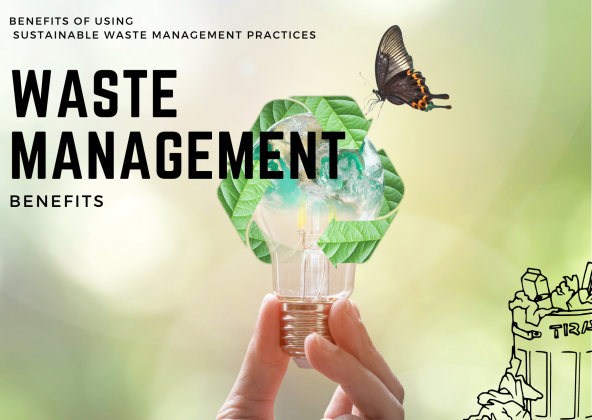9 Best Waste Management Practices: From Upcycling to Energy Conversion
Are you looking to make your life more sustainable but don’t know where to start? Reducing waste is a great first step. From food scraps to plastic packaging, waste can pile up quickly, impacting both the environment and your wallet.
1. Composting Organic Waste
Composting organic waste is an effective way to reduce environmental impact and manage household waste. Let’s dive into its benefits and how you can start composting at home.
Benefits of Composting
Reduces Landfill Waste: Composting significantly reduces the amount of waste sent to landfills. This, in turn, lowers methane emissions, a potent greenhouse gas.
Improves Soil Health: Compost enriches soil, adding essential nutrients and improving its structure. This leads to better plant growth and higher crop yields.
Saves Money: By creating your own compost, you reduce the need to buy commercial fertilizers. This can save you money over time.
Decreases Pollution: Composting helps reduce pollution by lowering the need for chemical fertilizers and encouraging cleaner, more sustainable gardening practices.
How to Start Composting at Home
Choose a Compost Bin: Select a compost bin based on your available space. Options range from simple DIY bins to more sophisticated tumblers.
Locate the Bin: Place your compost bin in a convenient location. It should be well-drained and receive partial sunlight.
Add Ingredients: Start by adding a balanced mix of “greens” and “browns.” Greens include fruit scraps, coffee grounds, and vegetable peelings. Browns consist of leaves, cardboard, and small branches.
Maintain the Pile: Regularly turn your compost to aerate it and speed up decomposition. Monitor moisture levels, ensuring your compost is damp but not waterlogged.
Harvest the Compost: Once your compost turns dark and crumbly, it’s ready to use. Apply it to your garden beds, potted plants, or lawn for a natural fertilizer boost.
By following these steps, you can create nutrient-rich compost, reduce your waste footprint, and contribute to a healthier environment.
2. Implementing Recycling Programs
Implementing recycling programs at home is essential for reducing waste and promoting sustainability.
Types of Materials You Can Recycle
Understand which materials are recyclable. Common items include paper, cardboard, plastics (numbers 1 and 2), glass bottles and jars, and metal cans. Remember to clean and dry these materials before recycling. Specific materials such as electronics, batteries, and light bulbs often require special recycling methods, so check local guidelines.
Setting Up a Home Recycling System
Organize your home recycling system effectively. Start by designating separate bins for different types of recyclables like paper, plastic, glass, and metal. Label each bin clearly and place them in a convenient location, like the kitchen or garage. Educate your family about the importance of proper sorting and frequent cleaning of recyclables. Monitor and adjust the system as needed to ensure participation and efficiency.
3. Using Biodegradable Products
Switching to biodegradable products is a significant step towards reducing waste and promoting sustainability. You can find a variety of options that are eco-friendly and support a healthier environment.
Advantages of Biodegradable Materials
Reduce Pollution. Biodegradable materials break down naturally, cutting down on waste in landfills and reducing pollution levels. Utilize these products to prevent long-term environmental damage.
Decrease Carbon Footprint. These products require less energy to produce and have a smaller carbon footprint. Opt for biodegradable items to make a measurable difference in greenhouse gas emissions.
Support Conservation. Using these materials aids in conserving natural resources. Choose biodegradable options to help preserve resources like water and fossil fuels.
Examples of Biodegradable Products to Use
Compostable Bags. Use bags made from plant-based materials for kitchen and yard waste. They’re a great alternative to plastic and decompose quickly.
Eco-Friendly Packaging. Select packaging made from biodegradable materials, such as cornstarch or mushroom-based products. These break down easily and are a fantastic substitute for traditional plastics.
Biodegradable Utensils. Switch to utensils made from bamboo or other plant-based materials. These options are sturdy and decompose much faster than plastic cutlery.
Natural Fiber Clothing. Choose clothes made from organic materials like cotton, hemp, or bamboo. These fabrics decompose naturally and are more sustainable than synthetic fibers.
By integrating these biodegradable products into your daily life, you contribute to a cleaner, healthier planet.
4. Reducing Plastic Use
There’s no denying that plastic waste is a growing problem. By reducing plastic use, you can significantly lower your environmental impact and contribute to a healthier planet.
Simple Ways to Cut Down on Plastic
- Use Reusable Bags: Carry reusable shopping bags for groceries and errands. They are sturdier and reduce plastic waste dramatically.
- Opt for Glass or Metal Bottles: Switch to glass or metal water bottles instead of buying plastic ones. This simple swap can save thousands of plastic bottles over a lifetime.
- Choose Packaging Wisely: Look for products with minimal or biodegradable packaging. Every small decision adds up to a big difference.
- Say No to Single-Use Plastics: Avoid items like straws, plastic cutlery, and disposable plates. Opt for reusable or compostable alternatives.
- Buy in Bulk: Purchasing items in bulk reduces the amount of plastic packaging. Bring your own containers to refill grains, nuts, and spices.
- Environmental Impact: Decreasing plastic waste reduces pollution in oceans and forests, protecting wildlife and their habitats.
- Health Benefits: Less plastic means fewer microplastics in food and water, which can improve overall health.
- Economic Savings: Reusable items, though often initially more expensive, save money over time by reducing the need for disposable products.
- Energy Conservation: Producing and recycling plastic consumes a lot of energy. Reducing plastic use lowers demand for energy and the fossil fuels required to produce it.
By making these small but effective changes, you’re supporting a cleaner, healthier world while reaping tangible benefits for yourself.
5. Proper Disposal of Hazardous Waste
Properly disposing of hazardous waste is crucial to protect your health and the environment. Follow these guidelines to manage hazardous materials responsibly.
Identifying Hazardous Waste
Recognize hazardous waste by its properties. Identify substances like paint, motor oil, batteries, pesticides, and cleaning chemicals. Check labels for warnings indicating flammability, toxicity, corrosiveness, or reactivity. Consult local resources for a complete list of hazardous household products.
Safe Disposal Methods
Utilize community hazardous waste programs. Find local drop-off sites or scheduled collection events for hazardous materials. Never pour chemicals down the drain or throw them in the trash. Use designated containers for items like batteries and electronics. Follow local regulations to ensure safe disposal.
6. Implementing Upcycling Techniques
Upcycling transforms waste materials into something valuable or useful again. It’s a creative and eco-friendly way to reduce waste and save resources.
What is Upcycling?
Upcycling gives new life to items that might otherwise be discarded. Unlike recycling, which breaks down materials to create something new, upcycling enhances an item’s original form. For example, turning old jeans into a stylish tote bag involves upcycling, whereas breaking down plastic bottles to create new ones is recycling.
- Glass Jars: Convert glass jars into storage containers. Use them for pantry staples, craft supplies, or even as decorative lanterns with some fairy lights inside.
- Wooden Pallets: Transform wooden pallets into furniture. Create coffee tables, bookshelves, or patio seating by sanding and staining the wood.
- Old T-Shirts: Repurpose old t-shirts into reusable shopping bags. Cut and sew shirts into bag shapes, reducing plastic bag usage.
- Wine Corks: Turn wine corks into custom coasters or bulletin boards. Glue corks together for unique, functional home decor.
- Tin Cans: Make tin cans into planters. Paint and decorate them to grow herbs, succulents, or flowers.
- Crates and Drawers: Use old crates and drawers as storage solutions. Stack and arrange them to create open shelves or unique storage units.
By integrating upcycling into your routine, you’ll reduce waste, save money, and add a personal touch to your home.
7. Utilizing Waste-to-Energy Systems
How Waste-to-Energy Works
Waste-to-energy (WTE) systems convert non-recyclable waste into usable energy. Various technologies like incineration, gasification, and anaerobic digestion break down waste and generate electricity or heat. Incineration burns waste at high temperatures to produce steam that powers turbines. Gasification converts organic materials into synthetic gas, which can be burned for power. Anaerobic digestion decomposes biodegradable waste to create biogas, used for electricity or heat.
Pros and Cons of Waste-to-Energy
Waste-to-energy systems offer several benefits and drawbacks. They reduce landfill waste volume by up to 90%, minimizing environmental impact. WTE systems also generate renewable energy, decreasing reliance on fossil fuels. Economically, they create jobs in the construction and operation of these plants. However, WTE processes can emit pollutants if not properly managed, posing health risks. Initial setup costs are high, and some argue that these systems may discourage recycling efforts since burning waste becomes a convenient disposal method. Balancing these pros and cons is crucial for effective waste management.
8. Advocating for Zero Waste Policies
Implementing zero-waste policies can significantly reduce the environmental impact of waste on our planet. These policies aim to minimize waste generation and maximize resource reuse.
What Are Zero Waste Policies?
Zero waste policies focus on eliminating waste generation and promoting sustainability. These policies encourage reducing, reusing, and recycling materials to keep them out of landfills. Cities like San Francisco have adopted zero-waste goals, aiming to divert 100% of waste from landfills through extensive recycling and composting programs.
How to Support Zero Waste Initiatives
Promote education and awareness by organizing community workshops and events. Advocate for legislation that supports zero waste, such as plastic bag bans and recycling mandates. Encourage businesses to adopt sustainable practices by offering incentives for reducing waste and using eco-friendly materials. Actively participate in local government meetings to push for the implementation of zero-waste policies in your community.
9. Educating Others on Waste Management
Workshops and Seminars
Organizing workshops and seminars can effectively spread awareness about waste management. These events allow you to share practical tips and strategies for reducing, reusing, and recycling. Invite local experts and organizations to speak, ensuring the information is credible and engaging. Encourage attendees to participate in hands-on activities, like sorting recyclables or creating DIY compost bins. Provide resources, such as pamphlets and links, to help them continue learning at home.
Impact of Education on Waste Reduction
Education significantly impacts waste reduction by changing behaviors and attitudes toward waste management. Engaged and informed individuals are more likely to adopt sustainable practices and influence others to do the same. Schools, community centers, and online platforms are excellent venues for delivering educational content. Highlight successful case studies and real-life examples to illustrate the benefits of waste reduction initiatives. This approach often leads to a ripple effect, amplifying the positive outcomes of educational efforts throughout the community.
Conclusion on Embracing Effective Waste Management Practices
Adopting sustainable waste management practices is essential for a healthier planet. By incorporating methods like composting, recycling, and upcycling, you can significantly reduce landfill waste and pollution. Waste-to-Energy systems offer an innovative way to convert non-recyclable waste into energy, though they come with their own set of challenges.
Zero Waste Policies and educational initiatives play a crucial role in changing behaviors and attitudes towards waste. Through workshops, seminars, and online resources, you can learn effective waste management strategies and inspire others to do the same. Real-life success stories demonstrate the profound impact these initiatives can have on communities.
By embracing these practices, you’re not only contributing to environmental sustainability but also fostering a culture of responsibility and awareness. Your efforts can create a lasting, positive change for future generations.





